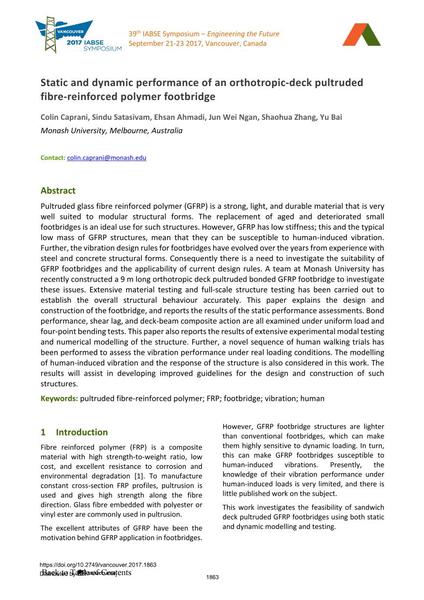Static and dynamic performance of an orthotropic-deck pultruded fibre-reinforced polymer footbridge

|
|
|||||||||||
Détails bibliographiques
| Auteur(s): |
Colin Caprani
(Monash University, Melbourne, Australia)
Sindu Satasivam (Monash University, Melbourne, Australia) Ehsan Ahmadi (Monash University, Melbourne, Australia) Jun Wei Ngan (Monash University, Melbourne, Australia) Shaohua Zhang (Monash University, Melbourne, Australia) Yu Bai (Monash University, Melbourne, Australia) |
||||
|---|---|---|---|---|---|
| Médium: | papier de conférence | ||||
| Langue(s): | anglais | ||||
| Conférence: | IABSE Symposium: Engineering the Future, Vancouver, Canada, 21-23 September 2017 | ||||
| Publié dans: | IABSE Symposium Vancouver 2017 | ||||
|
|||||
| Page(s): | 1863-1870 | ||||
| Nombre total de pages (du PDF): | 8 | ||||
| Année: | 2017 | ||||
| DOI: | 10.2749/vancouver.2017.1863 | ||||
| Abstrait: |
Pultruded glass fibre reinforced polymer (GFRP) is a strong, light, and durable material that is very well suited to modular structural forms. The replacement of aged and deteriorated small footbridges is an ideal use for such structures. However, GFRP has low stiffness; this and the typical low mass of GFRP structures, mean that they can be susceptible to human-induced vibration. Further, the vibration design rules for footbridges have evolved over the years from experience with steel and concrete structural forms. Consequently there is a need to investigate the suitability of GFRP footbridges and the applicability of current design rules. A team at Monash University has recently constructed a 9 m long orthotropic deck pultruded bonded GFRP footbridge to investigate these issues. Extensive material testing and full-scale structure testing has been carried out to establish the overall structural behaviour accurately. This paper explains the design and construction of the footbridge, and reports the results of the static performance assessments. Bond performance, shear lag, and deck-beam composite action are all examined under uniform load and four-point bending tests. This paper also reports the results of extensive experimental modal testing and numerical modelling of the structure. Further, a novel sequence of human walking trials has been performed to assess the vibration performance under real loading conditions. The modelling of human-induced vibration and the response of the structure is also considered in this work. The results will assist in developing improved guidelines for the design and construction of such structures. |
||||
| Mots-clé: |
passerelle
|
||||
